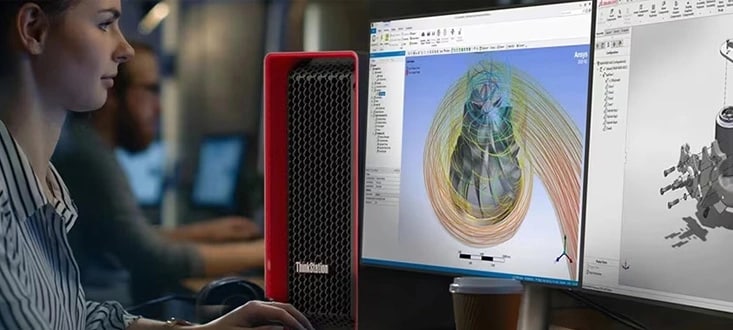-
Shop Lenovo Store
|
-

 Join a Community
Join a Community -

 Contact Us
Contact Us -

 Account
Account -

 Cart
Cart
Intel Core mobile processors (14th Gen)
Intel launched its 14th Gen Intel® Core™ mobile processors for laptops with a focus on performance—for gamers, creators, and multi-taskers. The top 14th Gen models offer higher boost speeds than earlier Intel® Core™ laptop chips, as we’ll explain. They work with today’s fastest memory modules, too, and support the latest advances in WiFi.
Most importantly, Intel’s 14th Gen laptop CPUs extend the company's performance hybrid core technology1 with more of the difference-making P-cores and E-cores than earlier mobile processor models. Your toughest tasks go to the high-performance P-cores while the ultra-efficient E-cores handle everything else. It's a great way to get power when you need it, while still maximizing battery life for longer time unplugged.
MORE FROM INTEL
Officially, these high-performance chips are called Intel® Core™ mobile processors (14th Gen). It’s a subtle change that moves the generation number from the start of the product name to the end, but it puts more focus on the different Core i9, Core i7, and Core i5 designs that consumers care most about.
In another change, Intel split its laptop processor offerings into two distinct brands. Starting with 14th Gen, the main Intel® Core™ mobile family (the subject of this article) includes the top-rated HX Series chips only. The mid-range H Series and super-efficient U Series laptop chips are now part of a new brand, Intel® Core™ Ultra mobile processors.
Lenovo offers a wide selection of laptops with Intel® Core™ processors, including powerful 14th Gen models. Keep reading to learn how these impressive CPUs can power your new mobile system, whether you’re looking for a portable workhorse for creative multi-tasking or a take-anywhere gaming rig to beat the competition.
What's new in Intel Core mobile processors (14th Gen)?
There's a lot to love in 14th generation Intel® Core™ laptop processors. From raw processing speed to lightning-fast data transfer and connectivity options, Intel packs a lot into each chip and the related components.
- Power when you need it: The top-most Intel® Core™ mobile processor (14th Gen) boasts up to 5.8 GHz turbo speed.2 Depending on your settings, it can kick in as needed to help process tough tasks faster and deliver smooth frame rates even in visually complex games.
- Speedy memory and data transfer: Intel's 14th Gen laptop CPUs support accelerated DDR5 memory3—and and some models can work with up to 192 GB RAM. Plus, Intel builds-in lots of advanced PCIe 5.0 transfer lanes,10 so your data zips back-and-forth with other components like the GPU.
- More P-core/E-core magic: Compared to earlier, similar chips, Intel has fit more Performance cores and Efficient cores1 on many of its 14th Gen mobile CPUs. This gives Intel(R) Thread Director4 more processor sectors to send your work to achieve maximum results with less energy.
- Connectivity & communications: With its 14th gen laptop processors, Intel added support for up to WiFi 7 (5 Gig) alongside already-popular WiFi 6E.5 And for cabled connections to high-speed peripherals, there's support for screaming-fast Thunderbolt™ 4.
IMPORTANT NOTE: The performance features and speeds listed here may differ based on which 14th Gen Intel® Core™ processor is selected, whether it's a Core i9, Core i7 or Core i5 design. And the announced support for new technologies like WiFi 7 still requires manufacturers to complement it with other, compatible components. So, always check the specs of any system you're considering to confirm it's got the exact features you desire.
The first systems powered by 14th Gen Intel® Core™ mobile processors debuted in 2024. Manufacturers such as Lenovo quickly offered multiple new Intel-powered laptops featuring the new chips. Keep reading to learn more.
14th Gen Intel Core laptop processors: Specifications
Table 1 lists the high-level specifications of Intel® Core™ mobile processors (14th Gen) at the time they were announced. Note that the maximum specifications shown here may not be available from every PC maker, such as Lenovo, because not all companies build systems with every available Intel CPU.
Table 1: Announced specifications of Intel® Core™ mobile processors (14th Gen) for laptops
|
Intel® Core™ i9 Processor 14900HX |
Intel® Core™ i7 Processor 14700HX |
Intel® Core™ i7 Processor 14650HX |
Intel® Core™ i5 Processor 14500HX |
Intel® Core™ i5 Processor 14450HX |
Performance-Core Max Turbo Frequency2 |
Up to 5.8 GHz |
Up to 5.5 GHZ |
Up to 5.2 GHz |
Up to 4.9 GHz |
Up to 4.8 GHz |
Efficient-Core Max Turbo Frequency |
Up to 4.1 GHz |
Up to 3.9 GHz |
Up to 3.7 GHz |
Up to 3.5 GHz |
Up to 3.5 GHz |
Processor Cores (P-cores + E-cores)6 |
24 (8+16) |
20 (8+12) |
16 (8+8) |
14 (6+8) |
10 (6+4) |
Processor Threads |
32 |
28 |
24 |
14 |
10 |
Intel® Thread Director4 |
Yes |
||||
Intel® Smart Cache (L3) |
36 MB |
33 MB |
30 MB |
24 MB |
20 MB |
Overclocking7 |
CPU, GFX & Memory |
||||
Processor Graphics |
Intel® UHD Graphics |
||||
Max Memory Speed3 |
Up to DDR5-5600, DDR4-3200 |
||||
Max Memory Capacity |
192 GB |
||||
CPU PCIe 5.0 Lanes10 |
Up to 16 |
||||
CPU PCIe 4.0 Lanes |
4 |
||||
Which Intel Core mobile processor (14th Gen) is for you?
The 14th Gen Intel® Core™ mobile processor line-up consists exclusively of high-performance HX Series models—long considered Intel's top consumer laptop chips. They're built to handle demanding workloads, like video production or intense game action, even when operating within a laptop chassis.
Laptops can be equipped with three different types of 14th Gen Intel® Core™ mobile processors:
- Intel® Core™ i9 mobile processors (14th Gen)—Peak performance for elite gaming and content creation
- Intel® Core™ i7 mobile processors (14th Gen)—Multi-tasking power to create, compete, stream, & record
- Intel® Core™ i5 mobile processors (14th Gen)—Versatile & capable for immersive gaming and productivity
As it introduced its 14th Gen processors in 2024, Intel made news by splitting its mobile CPU families in a new way. As recently as two generations earlier, the Intel® Core™ laptop line-up included not just the HX Series but also the mid-level H Series and P Series as well as the U Series for thin and light ultraportables. But in 14th Gen, only the souped-up HX Series remains, while the H Series and U Series chips are part of the Intel® Core™ Ultra mobile processor family, a new Intel brand that balances performance, portability, and long battery life for all kinds of laptop users.
In another change, it's anticipated that 14th Gen mobile processors are the last to use the famous Intel "i" in their name, as in Intel® Core™ i9 (or i7, or i5). Future models will use a simpler nomenclature, "Core™ 9," for example. And in conjunction with change described above to deemphasize the generation number in each product name, Intel is reminding consumers that they can always identify the generation of a given processor by looking at the first two digits of the model number, as in 14700HX.
14th Gen Intel Core laptop processors—Performance features
Intel® Core™ mobile processors (14th Gen) are power-packed with features aimed at giving mobile users what they want—top performance and long battery life. We’ve covered some of these technologies above, but here’s a more detailed look at the key performance features of 14th Gen Intel® Core™ laptop CPUs (see Table 2).
Table 2: Noteworthy performance features of 14th Gen Intel® Core™ laptop processors
FEATURE |
BENEFIT |
Performance hybrid architecture1 |
Enables distinct Performance and Efficiency cores on a single silicon die, with workloads distributed and prioritized to optimize output and battery life. |
Intel® Thread Director4 |
Helps the OS scheduler to intelligently distribute tasks to the best cores for the job, whether they’re Performance cores (P-cores) or Efficient cores (E-cores). |
Intel® Smart Cache (L3) |
An on-processor memory cache that helps keep your most critical data flowing speedily among the P-cores, E-cores and processor graphics (if applicable). |
Intel® Dynamic Tuning Technology |
Adapts power settings based on real-time usage and temperature readings to help keep your laptop running at optimum levels for the apps you’re using. |
Intel® Thermal Velocity Boost2 |
Increases clock frequency of select Intel® Core™ processors by up to 100 MT/s when it senses low-enough temperatures and available boost power. |
Intel® Extreme Tuning Utility |
Tuning and overclocking tools designed to help both new and experienced users to get the most from their unlocked Intel processors |
Intel® Adaptive Boost Technology (ABT)8 |
Increases performance by dynamically enabling higher multi-core turbo frequencies when current, power, and thermal headroom exists. |
Intel® Turbo Boost Max Technology 3.09 |
Monitors processor cores and directs critical workloads to the fastest available. |
Discrete Wi-Fi 7 Support5 |
Described as the “next step” in the evolution of wireless connectivity, helping provide even more extreme speed, responsiveness, and reliability. |
See what we mean? There’s a lot to like in 14th Gen Intel CPUs for laptops, whether you’re looking for extra boost power, more cores and threads than earlier generations, faster memory support, or new overclocking capabilities and tools. And you’ll find Intel® Core™ mobile processors (14th Gen) in a variety of Intel-powered Lenovo laptops. What are you waiting for?
NOTE: These 14th Gen Intel® Core™ laptop processors were preceded by other models, including 12th Gen Intel® Core™ laptop processors.
Intel, the Intel logo, Intel Evo, Intel Core, and Intel vPro are trademarks of Intel Corporation or its subsidiaries.
1 Performance hybrid architecture combines two core microarchitectures, Performance-cores (P-cores) and Efficient-cores (E-cores), on a single processor die first introduced on 12th Gen Intel® Core™ processors. Select 12th Gen and newer Intel® Core™ processors do not have performance hybrid architecture, only P-cores or E-cores, and may have the same cache size. See ark.intel.com for SKU details, including cache size and core frequency.
2 Intel® Thermal Velocity Boost: Only available on Intel® Core™ i7 processors (14th gen HX-series) and Intel® Core™ i9 processors (14th gen HX-series). For more information on Intel® TVB refer to https://www.intel.com/content/www/us/en/gaming/resources/how-intel-technologies-boost-cpu-performance.html?wapkw=thermal velocity boost
3 Memory Speed: Maximum memory speeds are associated with 1 DIMM per Channel (1DPC) configurations. Additional DIMM loading on any channel may impact maximum memory speed. Up to DDR5-5600 MT/s 1DPC UDIMM 1Rx8, 1Rx16 and DDR5-5200 1Rx8, 1Rx16, 2Rx8 on select SKUs. Maximum memory capacity is achievable with 2DPC configurations. For additional 2DPC configuration details, see ark.intel.com for SKU details.
4 Intel® Thread Director: Built into the hardware, Intel® Thread Director is provided only in performance hybrid architecture configurations of newer Intel® Core™ Ultra processors; OS enablement is required. Available features and functionality vary by OS.
5 Subject to network availability, operating system support, and router compatibility. Visit www.intel.com/performance-wireless for more details.
6 P-cores + E-cores: Processor cores listed first are the total number of cores in the processor. The number of Performance-cores and the number of Efficient-cores are listed in parentheses (P+E).
7 Intel® Application Optimization: Intel® Application Optimization is a policy within Intel® Dynamic Tuning Technology that optimizes performance on select games, with the required configurations on select Intel® Core™ 14th Gen processors. See intel.com/PerformanceIndex. Results may vary.
8 Intel® Adaptive Boost Technology: Intel® Core™ i9 mobile processors HX-series (14th gen) only.
9 Intel® Hyper-Threading Technology, Intel® Turbo Boost Max Technology 3.0, and Intel® Thermal Velocity Boost are only available on Performance-cores.
10 Minimum solution requirements, mandatory certification, and a 40 Gbps connection which provides the fastest connection as compared to other PC client bidirectional I/O connection technologies like eSATA and USB. Must be connection via Thunderbolt(TM) 3 or newer accessory to enable full performance. See www.intel.con/PerformanceIndex (connectivity) for details. Results may vary.




